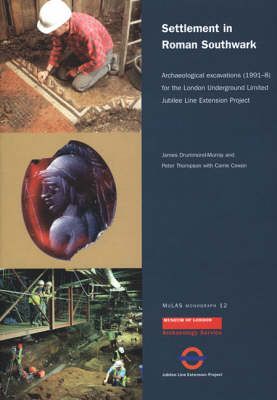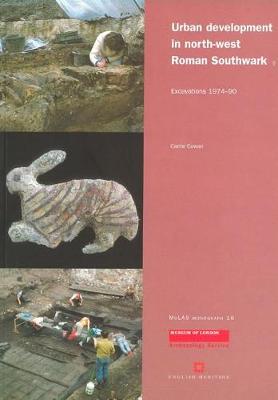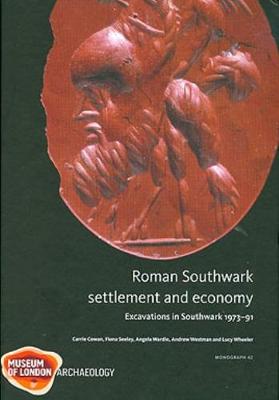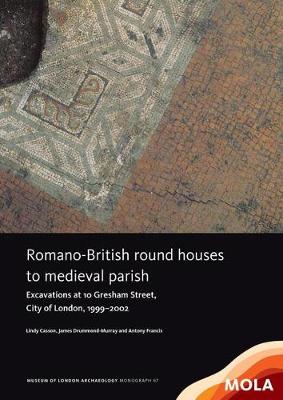MoLAS Monograph
5 primary works
Book 12
Settlement in Roman Southwark
by James Drummond-Murray, Dr. Peter Thompson, and Carrie Cowan
Published 12 February 2003
The latest in a series of reports on the archaeological excavations near London Bridge Station, this volume focuses on important discoveries relating to the origins and development of Roman Southwark. From the prehistoric period on this area formed the northernmost end of a series of sandy islands in the tidal reaches of the Thames. The earliest Roman features were drainage ditches and quarry pits associated with the construction of a road to the Thames bridgehead. Eight buildings were recorded along the eastern side of the road, including a blacksmiths' workshop. All of these buildings were destroyed by fire in the Boudican revolt of AD 60/61. New timber and masonry buildings were constructed in the area during the late 1st and 2nd centuries. These included shops, a market hall, and a warehouse. Excavations revealed that extensive land reclamation took place on the marginal eastern fringes of the island before the construction of 2nd and 3rd century houses. One of these houses contained a mosaic, and painted wall plaster was recorded to the west of the road with part of a large building interpreted as a mansio .
Book 16
The river crossing and access to the River Thames were major influences on the siting of Roman Southwark, where Watling Street and Stane Street converged. Excavations at Courage's Brewery revealed an archaeological sequence dating back to Prehistoric times. The Roman remains begin from AD40-55 and show the development of the site from the 1st to the 4th centuries, as the area increased in wealth before the occupation phase ended to be replaced with a cemetery. This excavation report provides important new information about the development of Roman Southwark, leading the way for further publication and research.
Book 25
Roman Pottery Production in the Walbrook Valley
by Fiona Seeley and James Drummond-Murray
Published 24 January 2006
Excavations have uncovered important new evidence of the second century AD Roman pottery industry, with up to eight kilns and a probable potters' workshop recorded on the west side of a major tributary of the Walbrook stream. Two distinct phases of production can be seen, and a stock of unused Samian ware from a pit suggests that pottery may have been sold in a shop attached to the production centre. The pottery industry went into decline in the latter half of the second century, though scattered structures, pitting and dumping were associated with the site in the third and fourth centuries. Research shows that the Roman kilns were producing Verulamium region white ware, linking them to the Verulamium industry, one of the most important regional producers of highly Romanised wares and specialist products such as mortaria.
Book 42
Roman Southwark - Settlement and Economy
by Carrie Cowan, Fiona Seeley, A. Wardle, Andrew Westman, and Lucy Wheeler
Published 14 February 2009
This report presents an overview of Roman urban development in London south of the Thames. The establishment of the Roman bridge and the first approach roads and landing places, made Southwark an ideal location for the development of facilities for the trans-shipment of goods between land and river. The wide range of data from 41 previously unpublished north Southwark sites provides the means for 'mapping' Roman activity in Southwark: the nature of the early settlement, changing patterns of land use and broader processes of social and economic change. Early land reclamation preceded the establishment of a thriving trade centre involved in the redistribution or marketing of locally processed and imported goods, with evidence of a concentration of buildings burnt in Boudican fire of AD 61 along the main road to the bridgehead. Increased land reclamation and construction of more masonry buildings in the 2nd century AD indicate further growth. By the 3rd century large stone buildings at ten of the sites reported suggest an administrative area housing official residences. After the mid 4th century the settlement contracted to the area immediately around the bridgehead with a cemetery on previously occupied land to the south.
Book 67
Romano-British round houses to medieval parish
by Lindy Casson, James Drummond-Murray, and Antony Francis
Published 30 April 2014
Good preservation in the western part of 10 Gresham Street has led to an unusually complete picture of the archaeological sequence.
The discovery here of the largest group of Romano-British round houses yet excavated in London, clustered round a rectangular building, is of considerable significance for the Iron Age–Roman transition. Moreover, the site’s main north–south road seems to have been key to determining the layout of this whole area while evidence pointing to sporadic fires in the 2nd century AD casts new light on the idea of a single, catastrophic event. Significant finds include a double gold finger ring of the 1st century AD, while close study of face pots and tazze leads to a rethinking of their possible ritual functions.
Abandoned from the late 4th/early 5th century AD until the 10th century, by the 12th century the site boasted at least four masonry buildings. The remains of several rare and expensive glass display vessels found in a 13th-century refuse pit indicate the presence of an extremely affluent household. Later, two taverns stood on the site or very close by, and significant numbers of vessels for storing and serving ale and wine were recovered. Considerable truncation of post-medieval structures and deposits, however, means that only the deepest cellars and cesspits survived from that period.
The discovery here of the largest group of Romano-British round houses yet excavated in London, clustered round a rectangular building, is of considerable significance for the Iron Age–Roman transition. Moreover, the site’s main north–south road seems to have been key to determining the layout of this whole area while evidence pointing to sporadic fires in the 2nd century AD casts new light on the idea of a single, catastrophic event. Significant finds include a double gold finger ring of the 1st century AD, while close study of face pots and tazze leads to a rethinking of their possible ritual functions.
Abandoned from the late 4th/early 5th century AD until the 10th century, by the 12th century the site boasted at least four masonry buildings. The remains of several rare and expensive glass display vessels found in a 13th-century refuse pit indicate the presence of an extremely affluent household. Later, two taverns stood on the site or very close by, and significant numbers of vessels for storing and serving ale and wine were recovered. Considerable truncation of post-medieval structures and deposits, however, means that only the deepest cellars and cesspits survived from that period.




